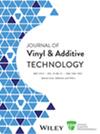Optimizing PVC photostability and UV blocking capability through nanoparticles incorporation: A comprehensive review
Abstract
Polyvinyl chloride (PVC) plays a crucial role in various sectors including industry, agriculture and medicine, primarily due to their affordability, durability, relative chemical inertness, versatility, and ease of processing. Nonetheless, the polymer experiences a serious damage (degradation) upon exposure to UV radiation from sunlight. UV light mainly induces dehydrochlorination, leading to the release of hydrogen chloride (HCl). This process results in the formation of conjugated alkene structures within the polymer backbone, causing weight loss, and deterioration in the PVC's mechanical and physical properties. This deterioration affects not only the material's structure and appearance but also its performance, particularly in outdoor environments. Many advancements have been made in developing UV protective and UV blocking agents to reduce the effect of the harmful light on the polymer and the substance contained within. Nanoparticles (NPs) encompass a wide range of organic, inorganic, and hybrid materials, which have proven an outstanding UV stabilizing effect on the polymer via different mechanisms including absorption, reflection, scattering, and radicals scavenging. The incorporation of NPs into the polymeric matrix not only enhances the photostability of it but also endow the polymer improved UV-blocking capability enlarging its application in various fields, most importantly packaging. While some of these NPs exhibit photocatalysis effect on the polymer and increase the rate of degradation, the surface modification can substantially reduce this effect. This review covers all research papers published since 2015 that investigate the use of nanoparticles not only as photostabilizers but also as UV-shielding agents, providing a comprehensive analysis of their applications. It also delves into the underlying mechanisms by which these nanoparticles enhance the photostability of the polymer matrix itself and the protection of the materials contained within it through the blocking of the harmful light. Additionally, it discusses recent strategies, especially surface modification, to enhance the dispersion of NPs in polymeric materials and decreasing the photocatalytic activity of NPs.
Highlights
- PVC is susceptible to degradation caused by UV radiation from sunlight.
- NPs are promising candidates for mitigating the harmful effects of UV light.
- Surface modification reduces photocatalytic degradation by nanoparticles.
- Homogeneous distribution of NPs in the polymer improves photostability.
- NPs endow polymers with UV-shielding capabilities for packing applications.




 求助内容:
求助内容: 应助结果提醒方式:
应助结果提醒方式:


